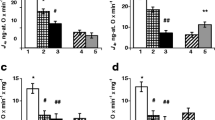Abstract
The low concentration of O2 in the thin air at high altitude is undoubtedly the reason for the remarkable modifications in the structure and function of the heart, lung, and blood of humans permanently living under these conditions. The effect of natural hypoxia on the energy metabolism of the cell is however not well understood. Here we study the proces of ATP synthesis in the heart of guinea pigs native to high altitude (4500 m) as compared with those native to sea level. The following are the novel findings of this study. (1) The rates and extents of ATP synthesis in the presence of low concentrations of ADP (<30 μM) are significantly higher at high altitude than at sea level. (2) The Hill coefficient, i.e. the degree of cooperativity between the three catalytic sites of the ATP synthase, is lower at high altitude (n = 1.36) than at sea level (n = 1.94). (3) Both, the affinity for ADP and the fractional occupancy of the catalytic sites by ATP, are higher at high altitude than at sea level but the P 50, i.e. the concentration of ADP at which 50% of the catalytic sites are filled with ADP and/or ATP, is the same (∼74.7 μM). (4) In the physiological range of ADP concentrations, the phosphorylation potential ΔG P is significantly higher at high altitude than at sea level. It is concluded that the molecular mechanism of energy transduction is profoundly modified at high altitude in order to readily and efficiently generate ATP in the presence of low concentrations of O2 and ADP.
Similar content being viewed by others
REFERENCES
Bienfait, H. F., Jacobs, J. M., and Slater, E. C. (1975). Biochim. Biophys. Acta 376, 446–457.
Boyer, P. D. (1979). In Membrane Bioenergetics: The Binding-Change Mechanism of ATP Synthesis (Lee, C. P., Schatz, G., and Ernster, L., eds.), Addison-Wesley, Reading, MA. pp. 461–479.
Boyer, P. D. (1997). Annu. Rev. Biochem. 66, 717–749.
Chance, B., and Williams, G. R. (1955). J. Biol. Chem. 217, 383–393.
Cross, R. L., and Duncan, T. M. (1996). J. Bioenerg. Biomemb. 28, 403–408.
Cross, R. L., Grubmeyer, C., and Penefsky, H. S. (1982). J. Biol. Chem. 257, 12101–12105.
Gnaiger, E. (2001). Respir. Physiol. 128, 277–297.
Gnaiger, E., Mendez, G., and Hand, S. C. (2000). Proc. Natl. Acad. Sci. U.S.A. 20, 11080–11085.
Hoppeler, H., and Vogt, M. (2001). J. Exp. Biol. 204, 3133–3139.
Jeneson, J. A. L., Wiseman, R. W., Westerhoff, H. V., and Kushmerick, M. J. (1996). J. Biol. Chem. 271, 27995–27998.
LaNoue, K. F., and Doumen, C. (1995). Adv. Mol. Cell Biol. 11, 207–232.
Lemasters, J. J., and Billica, W. H. (1981). J. Biol. Chem. 252, 12949–12957.
Lemasters, J. J., Grunwald, R., and Emaus, R. K. (1984). J. Biol. Chem. 259, 3058–3063.
Lemasters, J. J., and Hackenbrock, C. R. (1997). In Biomembranes: Continuous Measurements of Adenosine Triphosphate With Fire-fly Luciferase Luminescence (Packer, L., and Feischer, S., eds.), Academic Press, New York, pp. 703–716.
Matsuno-Yagi, A., and Hatefi, Y. (1990). J. Biol. Chem. 265, 82–88.
Milgrom, Y. M., and Cross, R. L. (1997). J. Biol. Chem. 272, 32211–32214.
Perez, J. A., and Ferguron, S. J. (1990). Biochemistry 29, 10518–10526.
Reynafarje, D. B. (1962). J. Appl. Physiol. 17, 301–305.
Reynafarje, D. B. (1966). In Symposia on Arctic Biology and Medicine: The Physiology of Work in Cold and Altitude (Helfferich, C., ed.), FT. Wainwright, Alaska.
Reynafarje, B. D., Costa, L. E., and Lehninger, A. L. (1985). Anal. Biochem. 45, 406–418.
Reynafarje, B. D., and Davies, P. W. (1990). Am. J. Physiol. 258 (Cell Physiol. 27), C504–C511.
Reynafarje, B. D., and Pedersen, P. L. (1996). J. Biol. Chem. 271, 32546–32550.
Slater, E. C., Rosing, J., and Mol, A. (1973). Biochem. Biophys. Acta 292, 534–553.
Stryer, L. (1995). In Biochemistry, W. H. Freeman and Co., New York, pp. 157–159.
Velasquez, T., and Reynafarje, B. D. (1966). Fed. Proc. 25, 1400–1402.
Author information
Authors and Affiliations
Corresponding author
Rights and permissions
About this article
Cite this article
Reynafarje, B.D., Marticorena, E. Bioenergetics of the Heart at High Altitude: Environmental Hypoxia Imposes Profound Transformations on the Myocardial Process of ATP Synthesis. J Bioenerg Biomembr 34, 407–412 (2002). https://doi.org/10.1023/A:1022597523483
Issue Date:
DOI: https://doi.org/10.1023/A:1022597523483




